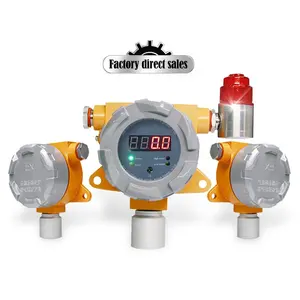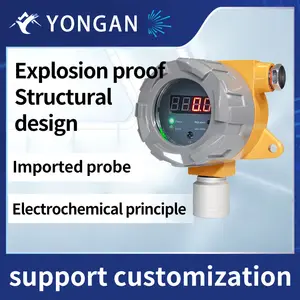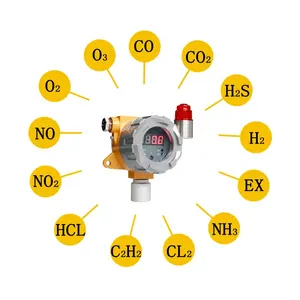(1499 products available)






















































































































































































The SF6 gas analyzer is an important tool for measuring SF6 gas and will help people in operating condition and quality and come in several types based on their measurement and functionality requirements.
This SF6 gas analyzer determines the purity level of SF6 gas. It comes with high accuracy in measuring the concentration levels of SF6 gas and other possible components of the gas mixture. The device usually has a range of 0-100% for SF6 gas purity measurement. The device uses an infrared sensor as its primary method of measurement, which gives a user an idea about the quality of the gas as it can be used to tell if any gas needs purification or replacement.
The moisture analyzer checks the moisture content of SF6 gas. It also has an infrared sensor to measure gas composition and a hygrometer tool to measure water vapor concentration in the gas. The analyzer helps provide accurate gas moisture readings and prevents gas mixture from becoming high in moisture, which reduces efficiency and reduces system failure.
The Portable high precision gas analyzer is used in plants where the gas is in use to identify possible leaks and give workers operating conditions. The analyzer is lightweight and offers on-the-spot measurements. They may differ in gas components analyzed, such as impurities or moisture content, but this depends on the model. This device typically offers an intuitive display and data logging capability to make it easy to use when taking important readings.
The decomposition product detectors are used to identify possible breakdowns or malfunctions in the system containing SF6 gas. These detectors work by analyzing gas samples and identifying the presence of sulfur compounds that shouldn't be in the gas. Many of them are also portable so they can be used effectively in the field. Some can give real-time analysis, while others may store data for analysis later.
SF6 gas is extensively used in the electrical industry, especially in high-voltage switchgears and circuit breakers due to its exceptional insulating properties. The SF6 gas analyzer is then used to ensure the gas is pure and free of moisture and contaminants and that the equipment works properly. Power plants and substations monitor gas composition and prevent equipment failures, increasing operational efficiency and safety.
In the metal manufacturing industry, the gas mixture is used in controlled environments for the production of semiconductor materials and stainless steel. The SF6 gas analyzer helps to keep the gas composition stable, minimizing defects in the final product and ensuring that the desired physical and chemical properties of the semiconductor material are maintained. This is especially important because variations in gas composition could lead to poor product quality in an industry where precision is everything.
The gas analyzers are used during transportation when moving equipment like circuit breakers to monitor the SF6 gas composition in the equipment, especially moisture content. It ensures no reactions take place during transit, which will affect the quality of the gas and the equipment. The SF6 gas analyzer helps provide quality control in the logistics process, ensuring that the equipment arrives without having to undergo changes that will affect its performance. This leads to enhanced safety because transporters are able to monitor decomposition products, which can be hazardous if allowed to accumulate.
Utility organizations and service providers use SF6 analyzers to test the gas mixtures in electrical components. The tools help them identify how much gas needs to be replaced or purified when they do field service and equipment maintenance. By quantifying gas composition, they can more easily troubleshoot issues and provide solutions. This leads to fewer call-outs and better gas monitoring so that equipment failure does not come with an SF6 gas mix that will be dangerous to work with.
SF6 analyzer features include the ability to measure a mixture gas pressure of about five barg, which is approximately 72.5 psig. It has a wide measurement temperature ranging from -20°C to +55°C, and this is important because it takes place outdoors and in industrial conditions that may not be very comfortable. The diagnostic tool can log more than 80 data sets to analyze how the gas mixture was kept in various situations. The device is powered by a rechargeable lithium-ion battery that can also be plugged in to avoid running out of work time.
The SF6 leak detection system is equipped with a measurement cell capable of measuring gas concentrations even at low levels of 1 part per million (ppm). This sensitivity makes it great for industries where even minor delays in the gas mixture will result in reduced efficiency or safety. The gas analyzer can record a maximum of eight consecutive readings to get an average value and probably eliminate outliers to help provide a better average reading and reduce the effects of any small measurement error. The system is also equipped with a three and a half inch colored graphic LCD screen for easy navigation and data input. The user interface also comprises a new keypad with distinctive function keys for convenient and straightforward handling.
The degree of purity of SF6 gas can be analyzed using an analyzer by following some easy steps. Users are advised to set the required measurement parameters on the device, such as pressure, temperature, and gas concentration levels. Connect the analyzer with the equipment containing the SF6 gas or the gas chamber and make sure the system is sealed correctly to avoid any possible leak. Turn the gas analyzer on and then let it collect data for some time. It will then analyze the gas composition and provide results that can be seen through the display screen.
Avoid leaving the gas analyzer in high or low temperatures for long to avoid damage to the device. The gas analyzer should be kept in a moderate space. Also, avoid any physical impact or shock with any surface or equipment to avoid impact on the components. After use, the device should be placed in a soft case to avoid scratches and dents on the surface. Be careful not to insert any sharp items inside the analyzer as they will cause serious damage to the internal components. The gas composition being analyzed should be free from any oil or moisture that could contaminate the internal parts.
SF6 gas is an extremely potent greenhouse gas, and the SF6 gas analyzer plays an important role in minimizing its environmental impact through careful monitoring of the gas composition to prevent any leaks or excess emissions.
The internal materials that come into contact with SF6 need to be resistant to this compound since it is highly electronegative and can react with certain metals to form harmful byproducts. Electronic sensors in gas analyzers should also be SF6-safe. SF6 leakage in critical areas poses health and safety issues because it can displace oxygen and cause asphyxiation or lead to increased concentration of sulfur compounds that come with their own dangers.
Environmental regulations often require that any emissions of SF6 be tracked and reported, so using these analyzers not only meets legal obligations but also helps to contribute to the reduction of greenhouse gases in the atmosphere. During transportation or storage, the gas analyzers should be placed in strong and durable packaging materials, such as hard cases, to prevent physical impact or collision with other equipment since this may damage them and lead to wastage. They should also be packaged in a way that they cannot be exposed to moisture or extreme heat, which can affect the functioning of electronic components or the integrity of the internal sensors.
SF6 analyzers themselves must be designed with rugged materials given the industrial settings they are often used in. Packaging must ensure sensitive components such as gas sensors remain protected so that they can keep providing accurate and reliable results. The devices should be tested regularly for possible wear and tear and maintained so that any safety issues from careless equipment failure can be addressed fast. Many analyzers have built-in safety features, such as automatic shutdown or alerts, when dangerously high concentrations of SF6 decomposition products are detected.
Only a few components in the SF6 gas analyzers can be repaired by the users themselves. The rechargeable batteries inside the SF6 gas analyzers can be replaced when they notice the device is experiencing low battery usage and is not responding even after charging it for a while. Also, the gas analyzer should be kept without gas for some time to avoid contact with the user. There are some delicate materials in the gas analyzers; users should avoid touching them.
Some electronic parts can be disconnected, and the new parts can be inserted, but disassembling the electronic parts is dangerous because there are so many small components that are interconnected. If the electronic parts are damaged during disassembling, they will be hard to repair. Users who don't have knowledge about electronics should avoid this step and get a professional for this task, so they don't end up damaging something that will be hard to fix from scratch. Mechanical parts have high chances of being repaired by yourself as they are easy to access.
When the intimate parts that contain sensors are to be repaired, professional help is a must because there is a high chance that users will damage them since they are very sensitive. Harsh chemicals or cleaning materials that contain strong chemicals should not be used to clean any part of the gas analyzers, as they may affect the internal components. Instead, use a dry cloth to clean it. Avoid using your hands while touching any internal components to prevent any incident.
A1: The SF6 gas analyzers are designed to measure the purity level of SF6 gas and the amount of moisture present in the gas to ensure the right balance for it to work properly and reduce the risk of harm.
A2: When the user places the gas analyzer near the input hole, the internal system takes a small amount of gas in and measures its pressure, temperature, and concentration of different compounds. After that, it gives a gas composition graph to the user through the display screen, showing the gas state.
A3:If well taken care of, the gas analyzers can last around four to five years. Proper maintenance and avoiding using it in harsh conditions will extend its durability.
A4:If the readings seem to be off and the new gas mixture seems to be the same but with different values on the display screen, this could be a sign the analyzer is worn out or there is something wrong with it.
A5:Some parts, like sensors and pumps, can be repaired easily. But other parts are so intertwined and have many components that one has to be very careful when doing this, one has to be very knowledgeable about it, and mechanical repairs are easier.